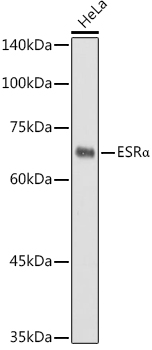Estrogen Receptor alpha antibody [1F3]
GTX70171
ApplicationsFlow Cytometry, ImmunoPrecipitation, Western Blot, ImmunoHistoChemistry, ImmunoHistoChemistry Frozen
Product group Antibodies
TargetESR1
Overview
- SupplierGeneTex
- Product NameEstrogen Receptor alpha antibody [1F3]
- Delivery Days Customer9
- Application Supplier NoteWB: 1:500-1:3000. IP: 1 - 5 microg/ml. *Optimal dilutions/concentrations should be determined by the researcher.Not tested in other applications.
- ApplicationsFlow Cytometry, ImmunoPrecipitation, Western Blot, ImmunoHistoChemistry, ImmunoHistoChemistry Frozen
- CertificationResearch Use Only
- ClonalityMonoclonal
- Clone ID1F3
- Concentration1.56 mg/ml
- ConjugateUnconjugated
- Gene ID2099
- Target nameESR1
- Target descriptionestrogen receptor 1
- Target synonymsER, ESR, ESRA, ESTRR, Era, NR3A1, estrogen receptor, E2 receptor alpha, ER-alpha, estradiol receptor, estrogen nuclear receptor alpha, estrogen receptor alpha E1-E2-1-2, estrogen receptor alpha E1-N2-E2-1-2, nuclear receptor subfamily 3 group A member 1, oestrogen receptor alpha
- HostMouse
- IsotypeIgG1
- Protein IDP03372
- Protein NameEstrogen receptor
- Scientific DescriptionThis gene encodes an estrogen receptor, a ligand-activated transcription factor composed of several domains important for hormone binding, DNA binding, and activation of transcription. The protein localizes to the nucleus where it may form a homodimer or a heterodimer with estrogen receptor 2. Estrogen and its receptors are essential for sexual development and reproductive function, but also play a role in other tissues such as bone. Estrogen receptors are also involved in pathological processes including breast cancer, endometrial cancer, and osteoporosis. Alternative promoter usage and alternative splicing result in dozens of transcript variants, but the full-length nature of many of these variants has not been determined. [provided by RefSeq, Mar 2014]
- Storage Instruction-20°C or -80°C,2°C to 8°C
- UNSPSC12352203
References
- Chang YC, Cheung CHA, Kuo YL. Tamoxifen Rechallenge Decreases Metastatic Potential but Increases Cell Viability and Clonogenicity in a Tamoxifen-Mediated Cytotoxicity-Resistant Subline of Human Breast MCF7 Cancer Cells. Front Cell Dev Biol. 2020,8:485. doi: 10.3389/fcell.2020.00485Read this paper
- Ma L, Yin W, Ma H, et al. Targeting claudin-3 suppresses stem cell-like phenotype in nonsquamous non-small-cell lung carcinoma. Lung Cancer Manag. 2019,8(1):LMT04. doi: 10.2217/lmt-2018-0010Read this paper
- Daurio NA, Tuttle SW, Worth AJ, et al. AMPK Activation and Metabolic Reprogramming by Tamoxifen through Estrogen Receptor-Independent Mechanisms Suggests New Uses for This Therapeutic Modality in Cancer Treatment. Cancer Res. 2016,76(11):3295-306. doi: 10.1158/0008-5472.CAN-15-2197Read this paper
- Mahajan K, Lawrence HR, Lawrence NJ, et al. ACK1 tyrosine kinase interacts with histone demethylase KDM3A to regulate the mammary tumor oncogene HOXA1. J Biol Chem. 2014,289(41):28179-91. doi: 10.1074/jbc.M114.584425Read this paper
- Ivanova MM, Mazhawidza W, Dougherty SM, et al. Activity and intracellular location of estrogen receptors alpha and beta in human bronchial epithelial cells. Mol Cell Endocrinol. 2009,305(1-2):12-21. doi: 10.1016/j.mce.2009.01.021Read this paper
- Sun M, Estrov Z, Ji Y, et al. Curcumin (diferuloylmethane) alters the expression profiles of microRNAs in human pancreatic cancer cells. Mol Cancer Ther. 2008,7(3):464-73. doi: 10.1158/1535-7163.MCT-07-2272Read this paper
- Srilatha B, Adaikan PG. Estrogen and phytoestrogen predispose to erectile dysfunction: do ER-alpha and ER-beta in the cavernosum play a role? Urology. 2004,63(2):382-6.Read this paper





